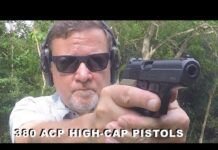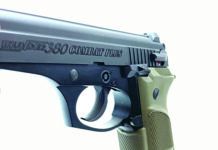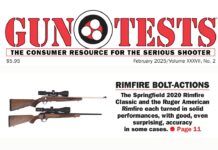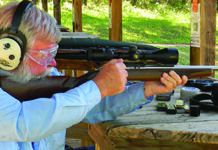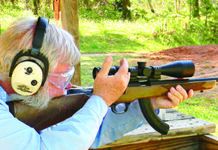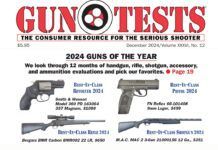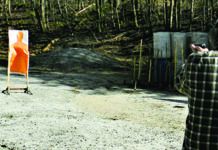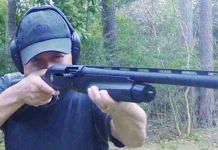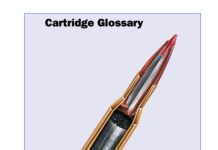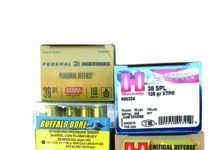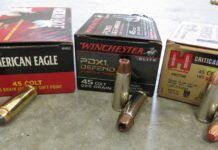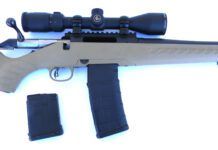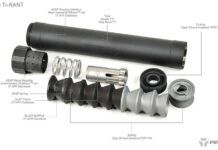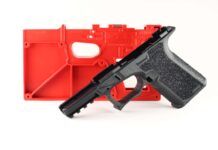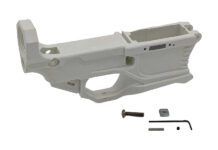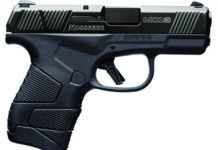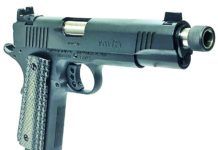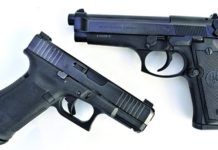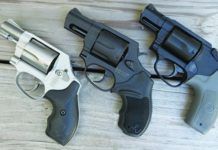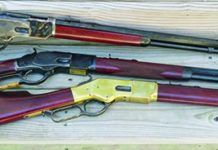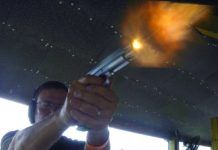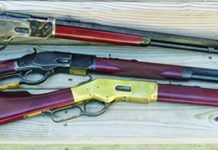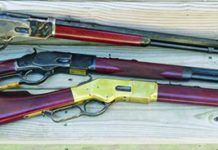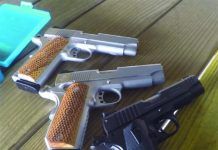March 2019 Short Shots: New Handguns for 2019
In celebration of the company's 100th anniversary, O.F. Mossberg & Sons, Inc., has released a 9mm concealed-carry handgun: the Mossberg MC1sc (subcompact). Surprisingly, the company's first firearm design, called the Brownie, was a 22-caliber four-shot pocket pistol. The MC1sc is available in five initial 9mm offerings: the standard MC1sc and an optional cross-bolt safety version; two standard offerings with sighting systems (TruGlo Tritium Pro Night Sights or a Viridian E-Series Red Laser), and a Centennial Limited Edition with a production run limited to 1,000 commemorative models. After 100 years in business, Mossberg has grown to be the sixth-largest U.S. firearms manufacturer with more than 100 design and utility patents to its credit. The MC1sc reflects three years of development. Important features in a subcompact handgun are size, weight, caliber and carryability. The MC1sc has an overall length of 6.45 inches, weight of 19 ounces (with empty magazine), and a barrel length of 3.4 inches in the popular 9mm chambering. It comes with two single-stack magazines (one 6-round flush and one 7-round extended), has a glass-reinforced polymer frame, and suggested retail price of $421 for the two standard models.
Walther Announces Relaunch of the Classic PPK and PPK/S Pistols
Hey Gun Tests readers, I'm Todd Woodard, editor of Gun Tests Magazine. I'm here with Bret Vorhees, director of product development for Walther. And amazingly, we have a gun here that you already know about, the Walther PPK/S. Walther's PPK and PPK/S are coming back out in the United States this year.
Bret's going to tell us about the long story of this platform and why it's an interesting gun for shooters.
NYC Gun Law to Face Supreme Court Test
Currently, New York City law unconstitutionally limits its residents' ability to transport their guns outside of their homes. NYC residents can carry a licensed, locked and unloaded handgun to one of seven shooting ranges within city limits, but nowhere else, including homes or shooting ranges outside of the city.
Threaded-Barrel 1911 Pistols: Some Choices Come Up Short
Last year, we began testing suppressors on rifles and handguns because we saw that the sound-abatement equipment was becoming a lot more popular. This was a surprise because suppressors are expensive and hard to transact, so it takes a lot of patience and money to get started, and there is a fair amount of legal liability if you get it wrong. Despite these drawbacks, since we began this journey suppressor regulations have become much more relaxed across the country, with all but a handful of gun-restrictive states allowing the devices. Still, it will take a couple of generations for suppressors to become mainstream and for the misconceptions about them to evaporate. For some, these unobtrusive pieces of hollow metal will always be tied to clandestine assassin or spec-ops use rather than as portable hearing protection. Pity, because during our testing with them, we have found a lot of salutary benefits behind the gun, whether long gun or sidearm. Suppressed firearms not only have shown better accuracy in most cases, they are certainly better mannered with a can hanging off the front. Muzzle flip and blast are easier to control with a can in place, and that improves accuracy and enjoyment.
We initially chose handguns chambered in 45 ACP because they offered a lot of full-power bullet weights and shapes that run below the speed of sound, so it's easy to find good ammo that suppresses well. For the handguns, we started with three full-size non-1911 45s from Glock, HK, and FN, all of which come from the factory suppressor-ready. Reviewed in the September 2018 issue, we recommended the FN America FNX-45 Tactical FDE 66968 45 ACP, $1200. We had function trouble with a Glock G21SF PF2150203TB 45 ACP, $511, and didn't recommend it. The third polymer gun was the Heckler & Koch Mark 23 45 ACP M723001-A5, $2300. It was big and expensive and very nice to shoot. Some of our testers said that if they were to buy the HK Mark 23, they would remember the day as fondly as when they got their favorite dog, which is high praise indeed.
Our 1911-style test guns this time included the Kimber America 1911 Warrior SOC 3000253 TFS with Crimson Trace Rail Master Laser Sight, $1309. We had loan of this immaculate early-model SOC with about 250 rounds through it, half of which were fired with an Osprey 45 suppressor like the one in this test. The Warrior SOC has an accessory rail built into the dust cover, which allows fitting a desert-tan Crimson Trace Rail Master laser as part of the package.
The second gun was a Remington 1911 R1 Enhanced Threaded Barrel 96339, $675, a recent in-stock price from TombstoneTactical.com. This was a well-outfitted gun for the money, coming with the 5.5-inch barrel threaded .578-28 like the others, two 8-round magazines with bumper pads, and a lot of other features we detail below.
9mm Striker Gun Shoot-out: Beretta, Glock, and SIG Sauer
To replace the Beretta M9A1 (M9) and later variants in military service, the U.S. Army tested several handguns and chose the SIG P320, which is designated as the M17 in military service. The Glock 19X was also a participant in the military trials. While not chosen by the military, the full-size-grip short-slide Glock has enjoyed commercial success. The new Glock 45 is a direct result of Glock's experience in the military trials and also a result of criticism of the 19X. A third handgun, Beretta's APX, was also not adopted, and like the M17, is a modular design. We elected to test these three striker-fired polymer handguns head to head to determine which might be the best choice for concealed carry and personal defense for civilians. To add some historical texture, we also shot these firearms side by side with a full-size Beretta 92, or the M9 in its military appellation. The Beretta won't carry as easily as the APX and Glock, but it's comparable to the P320-M17 in size. If we're looking at them as home-defense guns, then size is less of an issue.
As we collected data and choose firearms for inclusion in these shoot-outs, we met old-line shooters and even young shooters who feel that the polymer-frame striker-fired market is crowded, and these handguns are much the same. Nothing could be further from the truth. Beretta, CZ, HK, SIG, Smith & Wesson, and Glock offer different features and different fits and feel for their products. Those who have not tested the pistols extensively and who have not taken time to compare features may feel these pistols are cut from the same cloth, but by assuming that, those shooters abrogate a lot of responsibility in choosing the handgun that suits them best.
New Snubnose Revolvers Under $400: S&W, Taurus Compete
Snubnose revolvers are viable options when deciding what type of self-defense firearm to purchase. They are easy to use and easy to conceal. Plus, the 38 Special cartridge is an excellent self-defense round, and 38 Special +P loads are almost as powerful as a 357 Magnum rounds. We procured three snubnose revolvers under $400 — the Smith & Wesson Model 637-2, Smith & Wesson M&P Bodyguard 38, and the Taurus Model 856 — to see which one would come out as top dog.
In our opinion, all three of these snubnose revolvers are good choices for concealed carry and home defense. All have attributes that make them well suited for conceal carry, such as light weight, small grips, and smooth, snag-free outside edges. Sights are a big consideration, and we like them large and easy to use, and if we have the ability to modify the sight, that is a plus in our book. The triggers also need to be smooth because these revolvers will mostly likely be fired in double-action (DA) mode. Plus, we think the ability to fire 38 Special and 38 Special +P ammo through the revolver enhances its versatility.
38 Special Problem in 357 Mags
I enjoyed the article on 38 Special lever-action rifles, but I think you missed a very important warning. The 38 Special and 357 Magnum are not interchangeable, for reasons other than the strength of the action. I have a Marlin lever action in 357 caliber. I decided to sight it in with 38 Special rounds and then change to 357 and adjust the sights. After about 20 or 30 rounds of 38 Special, I switched to 357. When I tried to rack in the second round, it wouldn't seat. The problem was that the 38 Special rounds carboned up the chamber, and when the 357 round was extracted, only about half of the cartridge came out. I had to have a gunsmith remove the front half of the casing. I only shoot 357 rounds in my rifle and revolver since then. I have never seen this in any article which discusses using 38 Special ammo in a 357 chamber.
2018 Guns & Gear Top Picks: Firearms
38 Special Problem in 357 Mags
I enjoyed the article on 38 Special lever-action rifles, but I think you missed a very important warning. The 38 Special and 357 Magnum are not interchangeable, for reasons other than the strength of the action. I have a Marlin lever action in 357 caliber. I decided to sight it in with 38 Special rounds and then change to 357 and adjust the sights. After about 20 or 30 rounds of 38 Special, I switched to 357. When I tried to rack in the second round, it wouldn't seat. The problem was that the 38 Special rounds carboned up the chamber, and when the 357 round was extracted, only about half of the cartridge came out. I had to have a gunsmith remove the front half of the casing. I only shoot 357 rounds in my rifle and revolver since then. I have never seen this in any article which discusses using 38 Special ammo in a 357 chamber.
38 Special Problem in 357 Mags
I enjoyed the article on 38 Special lever-action rifles, but I think you missed a very important warning. The 38 Special and 357 Magnum are not interchangeable, for reasons other than the strength of the action. I have a Marlin lever action in 357 caliber. I decided to sight it in with 38 Special rounds and then change to 357 and adjust the sights. After about 20 or 30 rounds of 38 Special, I switched to 357. When I tried to rack in the second round, it wouldn't seat. The problem was that the 38 Special rounds carboned up the chamber, and when the 357 round was extracted, only about half of the cartridge came out. I had to have a gunsmith remove the front half of the casing. I only shoot 357 rounds in my rifle and revolver since then. I have never seen this in any article which discusses using 38 Special ammo in a 357 chamber.
9mm Slim Line Compact Pistol Shoot-out: Five Go Head To Head
Close in importance to the most basic needs - food, water, and shelter - is the ability to protect yourself from threats. Concealable, compact, and powerful handguns give us peace of mind in a dangerous world. There is no doubt there are more effective cartridges than the 9mm Luger, but the 9mm is far more powerful than any 32 ACP or 380 Auto cartridge, and it holds more rounds than a compact 38 Special revolver. The 9mm is a powerful cartridge with good performance that will get the job done, given adequate shot placement. A compact handgun with good sights, a decent trigger, and ergonomic controls is a stalwart companion in difficult times. So we tested a quintet side by side to get an idea about what we would buy, then relay those impressions to Gun Tests readers. The pistols tested are unique in many ways, but they share a few common features. Takedown, trigger action, and slide-lock designs differ. Each may fit your needs more than the others, but there are a couple at the top of the heap. Our test handguns chambered in 9mm Luger were the following.
We Compare Three New 45 ACP 1911 Commanders Under $750
The 1911 Commander is basically a full-size pistol receiver with a shorter 4.25-inch barrel and slide. These 1911 variants are more compact than the full-size issues, yet they offer all the features of the standard 5-inch-barrel variant, albeit with a bit less velocity. Some members of our team like the Commander format with the full-size grip and shortened slide, which makes the pistol easy to hang onto when firing 45 ACP as well as more comfortable to carry concealed due to the shorter barrel. One issue when carrying concealed, though, is the grip, which can print under clothing.
To see which pistol best fit our testers' everyday-carry needs, we procured three 1911 Commander models for testing: the recently introduced Taurus 1911 Commander ($459), a Metro Arms MAC 1911 Bobcut ($746), and an American Classic Commander ($568). The Taurus is manufactured in Brazil, and the Metro Arms and American Classic pistols are manufactured in the Philippines and are both brought into this country by Eagle Imports.
All three showed great fit and finish and chewed through 45 ACP ammo as fast as we could load magazines. All featured the classic GI-style domed slide, long skeletonized triggers and hammers, straight rear grip straps, dovetailed combat-style sights, flared ejection ports, extended beavertails, extended thumb safeties, textured grips, and 8+1 round capacities. In short, these pistols have all the features a modern 1911 shooter expects in a concealable package.
The Bobcut and AC came in hard-plastic cases and included one magazine. The Taurus included a plastic bushing wrench for ease of takedown. At first glance, these three Commanders looked the same in terms of features, if not cosmetics, and it was the value-added items in each that eventually allowed us to judge one over the other.


